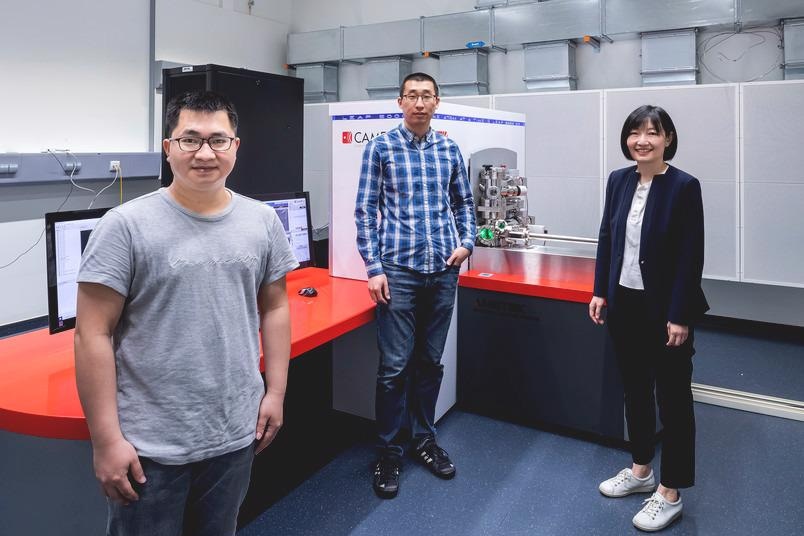Detailed imaging of catalyst surfaces has rarely been done before. However, every single atom can still perform a decisive role in catalytic activity.
 Members of the Bochum-based research team in the lab: Weikai Xiang, Chenglong Luan and Tong Li (from left to right). Image Credit: ©Privat.
Members of the Bochum-based research team in the lab: Weikai Xiang, Chenglong Luan and Tong Li (from left to right). Image Credit: ©Privat.
A German-Chinese research group has envisioned the three-dimensional structure of the surface of catalyst nanoparticles at atomic resolution. This structure performs a decisive role in the activity and also the stability of the particles. The elaborate understanding was obtained with a combination of atom probe tomography, electron microscopy, and spectroscopy.
Nanoparticle catalysts could be utilized, for instance, in the production of hydrogen for the chemical sector. To improve the performance of future catalysts, it is crucial to comprehend how it has been impacted by the three-dimensional structure.
Scientists from the Ruhr-Universität Bochum (RUB), the University of Duisburg-Essen, and the Max Planck Institute for Chemical Energy Conversion in Mülheim an der Ruhr collaborated on the project as part of the Collaborative Research Centre “Heterogeneous oxidation catalysis in the liquid phase.”
At RUB, a group guided by Weikai Xiang and Professor Tong Li from Atomic-scale Characterization collaborated with the Chair of Electrochemistry and Nanoscale Materials and the Chair of Industrial Chemistry. Furthermore, institutes in Shanghai, China, Didcot and the UK, also played a part. The group presented their study outcomes on January 10th, 2022, in the Nature Communications journal.
Particles Observed During the Catalysis Process
Two different types of nanoparticles were studied by the researchers made of cobalt iron oxide that measured nearly 10 nm. They examined the particles at the time of the catalysis of the alleged oxygen evolution reaction. This is a half-reaction that takes place during water splitting for hydrogen production: hydrogen can be obtained by splitting water utilizing electrical energy; oxygen and hydrogen are generated in the process.
The bottleneck in the development of highly efficient production processes is the partial reaction in which oxygen is developed — the oxygen evolution reaction. This reaction tends to alter the catalyst surface that becomes inactive eventually. The compositional and structural alterations on the surface play a crucial role in the activity and stability of the electrocatalysts.
In the case of small nanoparticles with a size around 10 nm, achieving thorough information regarding what happens on the catalyst surface during the reaction is still a challenge. With the help of atom probe tomography, the researchers were successful in envisioning the distribution of the various kinds of atoms in the cobalt iron oxide catalysts in three dimensions.
By integrating it with other techniques, they illustrated how the structure and composition of the surface altered during the catalysis process — and how this change impacted the performance of the catalyst.
Atom probe tomography has enormous potential to provide atomic insights into the compositional changes on the surface of catalyst nanoparticles during important catalytic reactions such as oxygen evolution reaction for hydrogen production or CO2 reduction.
Dr. Tong Li, Professor, Ruhr-Universität Bochum
The German Research Foundation financially supported the project under project no. 407513992 an under the umbrella of Collaborative Research Centre/Transregio 247 “Heterogeneous oxidation catalysis in the liquid phase” (project no. 388390466).
Journal Reference:
Xiang, W., et al. (2022) 3D atomic-scale imaging of mixed Co-Fe spinel oxide nanoparticles during oxygen evolution reaction. Nature Communications. doi.org/10.1038/s41467-021-27788-2.